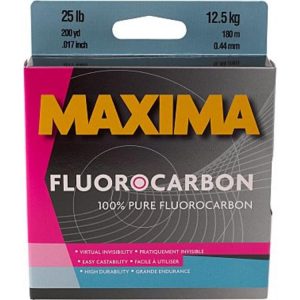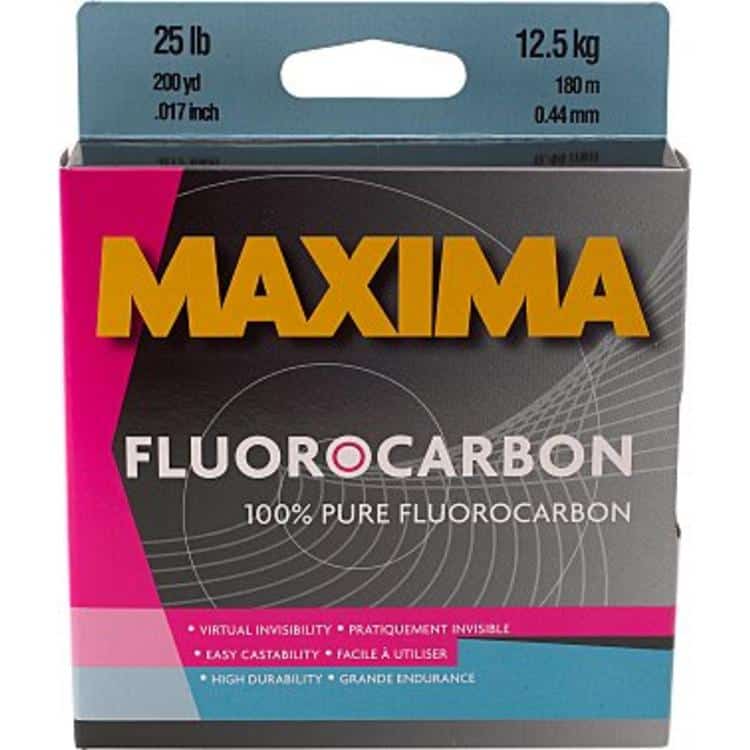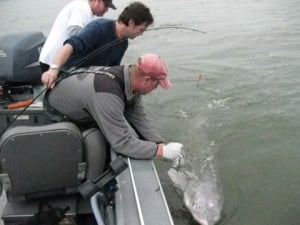Check out our Astoria Fishing Charters and Washington Halibut Charters

It used to be that anglers just had one decision to make when buying fishing line and that was determining how strong their line needed to be. “Hmmm do I need 6 pound or 8 pound?”
Nowadays it’s a little tougher, there are lines that promise to do everything but clean and cook the fish! Tougher, smoother, more visible, invisible, stiffer, thinner, abrasion resistant, and the list goes on and on. Let’s forget about all of the features that are available across the myriad of brands and focus on one easy decision, why should I use fluorocarbon instead of traditional monofilament line?
Monofilament is actually the term that can be generically applied to all single strand fishing lines, the more accurate term when we are talking about “good old mono” is nylon.
Both nylon and fluorocarbon are essentially plastic lines that are made by extruding hot resin through tiny holes, taking what was once a hot soup of plastic and making it into a long thin filament of line. What makes the two products unique is the resin. It’s the stuff that’s in the soup that makes or breaks the line!
Dupont introduced the world to nylon in 1938 and in 1939 they created the world’s first nylon fishing line. However it wasn’t until 1959 when Dupont introduced the Stren brand that nylon fishing line rose above braided Dacron to become the standard line in use by most fishermen here in the U.S.
Seaguar was the first fluorocarbon line ever made, and it has been around since 1971 when it was invented by Japan’s Kureha line company. Seaguar eventually found its way to the United States in 1992.
Fluorocarbon is being used by more and more fishermen because:
- It’s known for its exceptional abrasion resistance.
- Low stretch.
- Its ability to almost disappear under water.
- It’s very dense which makes it sink well. Fluorocarbon will not float. Pay attention dry fly fishermen!
- Normal heat, cold, and water have little effect on the strength of the line.
- Doesn’t absorb water like nylon.
- Since it has low stretch it provides better sensitivity.
- Fluorocarbon is chemical resistant. Nylon isn’t, so be careful with that bug spray and sunscreen when using nylon!
Several years ago, fluorocarbon lines had an issue with knot strength but this is no longer the case. More manufacturers coming on line with more advanced equipment and resins have resulted in a very high tech product with exceptional knot strength.
Ultraviolet rays from the sun, the heat of a hot car and cold winter fishing have an insignificant affect on fluorocarbon.
Fluorocarbon will last longer on the spool than nylon. You still have to re-spool when the line is looking bad or frayed, but with fluorocarbon you will have to do this less often.
When buying fluorocarbon lines and leaders it is important to know that even though you are buying the same brand name, you may not be getting the same line in each package. This is a good thing because leader and main line perform different functions and need different characteristics. The manufacturer may not be using the same resin or process to make both its leaders and lines. Leaders are often designed to be stiffer and with less stretch whereas that same manufacturer’s line may be flexible with little memory and since it is intended for use as main line it will have more stretch.
We personally use braided main line, but use Maxima fluorocarbon leader material when fishing for salmon, steelhead and trout. I have found this material to be incredibly strong, and because it is so abrasion resistant it allows me to step down to a lighter leader such as 25 pound for spring Chinook and 40 pound for fall Chinook.
When I was using nylon leader, I would use 30 pound in the spring and 50 or even 60 pound in the fall. We use the heavier lines in the fall because the salmon have harder, sharper teeth that will just slice through soft nylon lines. Since switching to fluorocarbon I have not had a single Chinook bite through the line.
If there were any draw backs to using fluorocarbon line it would have to be that it is so darned expensive. This is the next generation of fishing line and the fluorocarbon manufacturing process uses the latest technology and in general it’s just more expensive to produce than nylon.
100% fluorocarbon can cost several times more than nylon, but it also catches more fish and lasts at least twice as long. Maxima fluorocarbon is the only brand that we currently use. There are some cheap fluoro resins available in other lines as well as fluoro-coated nylon lines, but nothing beats using the real thing when you fish for a living or if you live for fishing!



Kevin,
Enjoyed the article and it really makes you think, the tough part is making a switch to something else. I a tried and true Izorline fisherman, have tried other brands and keep going back.
Will have to look for some next time I’m out shopping, never hurts to experiment.
Thanks
Rob
Kevin,
Great topic, something we all buy and use. Right now I run P-line fluorocarbon and it’s not to bad, you told me about the Sufix fluorocarbon and I might just make the switch. Again, thanks for the article and nice work!
Thanks,
Chris
Thanks for the fresh topic. Rather do this than watch the Beavers lose…..
Knot strength:
Yea, ya hear about this all the time and lots of Salty Dogs say Seaguar is the only product that works. Although I personally have never had a problem with any fluorocarbon leader I’ve tried, there might be some bad stuff that actually exists. Whatever we’re using, it is no better than the knots that hold everything together. I’d guess many new and many experienced fishermen, are poor knot tiers or use the wrong knots and look for another excuse as to why something has failed. It doesn’t matter what product they use, they’re going to have knot failure. Heck, we all have knot failure from time to time. Sometimes it’s coincidence, sometimes it’s our own fault. I never blame it on the product unless a trend suddenly appears and if it does, toss the whole spool and get some fresh. I’ve had this happen only a couple of times. Proper knot tying involves wetting the line/leader with saliva and pulling the knots up slowly. If we pull quickly, we’ll burn the leader between the wraps and the hook shank, no matter how much saliva we’ve applied. Think about this when you’re tying really long leaders for herring rigs.
Do we need fluorocarbon? All I can say is, maybe under certain conditions. The times I use it is when live bait fishing and slow trolling swimbaits for tuna. The only reason I do is because that’s the way the “experts” do it. Should we use it for salmon and steelhead? I seriously doubt it’ll result in more hookups no matter how clear the water is. The point made about it lasting longer when on reels and under all the adverse conditions it may be exposed to, is valid. If I were a guide, I’d certainly follow the advice given and switch. Personally, I think Maxima Ultragreen has improved tremendously since it first came on the market and has excellent life on a reel. So does P-Line CXX, which also has a small diameter and breaks well above its rating. We used to use the old Maxima brown line exclusively for fall Chinooks but would change every two days and sometimes every day if we’d caught a few fish which is usually what happened. It had very poor reel life. The only fluorocarbon type product I’ve used for steelhead is the P-Line Fluoro coated copolymer product as leader material. Some say it’s no good, I haven’t broken any fish off and it takes considerable effort to break it on snags. Do we need fluoro to withstand the teeth of Chinooks. I’ve never cut a leader on a chinook when I used material that was at least 25 lb test. If I were a guide, I’d give switching a lot of thought. It’s always smart to follow the advice given by guides who have to take things more seriously than sportfishers like me. I’ve caught a lot of ocean and B-10 Coho on 10 and 12 lb test P-Line CXX leaders, although I generally use 30 lb UG or 40 if I’m targeting Chinooks. I wouldn’t feel undergunned using 8 lb CXX as mainline for ocean Coho but you couldn’t use divers with that stuff. I never use divers…..except for tuna…..
I started using floruocarbon exlcusively for spring chinook two years ago. I started using it because I had gotten it as part of a “grab bag” at a seminar I had attended. All I can say is I know it definteily doesn’t hurt your chances and on days when not alot of fish are being caught, I think it can be a difference maker in the presentation. I have never had a knot slip or broke off a fish with the flourocarbon. Some folks don’t feel the little advantage it gives you is worth the extra expense. But when you consider how difficult it is to catch spring chinook anyways, why wouldn’t you want every advantage you could afford?